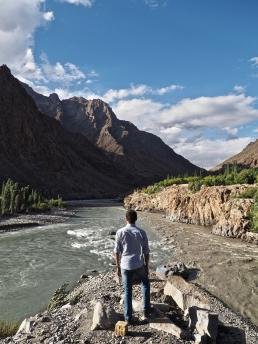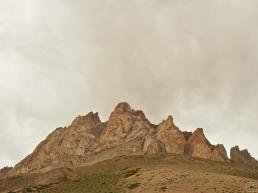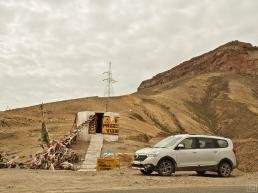Ladakh has an almost mystical presence in the upper reaches of the Himalayas. It’s tough to get to, requires careful planning, and is widely considered to be one of the toughest drives you’ll take in your lifetime. Most people consider it to be a once in a life time experience. I thought it was about time to challenge some of those myths – and explore one of the most beautiful regions of the world for myself.

Our journey started in Delhi. Prathik would join me for this journey from Delhi. Photographing Ladakh is a special occasion, and we’d been planning this trip for about five years now. It was nice to see we finally were making it happen.
I was also joined by 2 other friends, Benjamin & Ameya. Both avid travellers, they have a knack for noticing and appreciating nature.
I’d flown into Delhi the previous night. My flight was delayed by an hour, and by the time I reached my overnight stop, it was 3am. Nonetheless, we were up at 9 in the morning, and all ready to depart by 10am.
It was going to be a long drive. We were planning to hit Pathankot and stay there for the night – the next day, we’d drive past Srinagar and into Sonamarg. Followed by Kargil the next day. Followed by Leh.

Over the next 4 days, the landscape around us would change completely. We’d go from a bustling city like Delhi with toxic or near toxic air to the land of high passes, massive mountains, clear skies and cool, light air.
It’s difficult to fathom the extent of this change, but Ladakh is a different world in itself. While you’re there, it’s not difficult to imagine that you’re on a different planet – away from earthly settlements. Life is different – it’s simpler in some ways and harsher in others. But we’ll get to that a bit later.
Our car for the chore was a Renault Lodgy Stepway – a 7 seat family MPV made to do school runs. Used as a taxi in some parts of the world, and here it was – all ready to conquer everything the Himalayas were to throw at it. No, this car didn’t come with four wheel drive, it didn’t come with off-road tech, it didn’t come with fancy off-road tyres.
It did come with a punchy 110PS engine, 4 captain’s chairs, lots of luggage space and 174mm of ground clearance. The last bit there was in hindsight, the most crucial spec on that car.
What a terrible choice I told myself. There we were in Delhi, trying to wade through the Himalayas and into Ladakh – one of the toughest drives in the world – in a people mover. This could only go south.
But it didn’t.

Our drive to Pathankot on Day 1 was largely unspectacular and without incident. It took us about 10 hours, including stops, from Delhi. Our overnight halt was at Hotel Venice. Decent place for an overnight halt.
On the second day, we drove to Sonamarg. This was one of our longest driving days. Driving through Jammu into Kashmir, past Srinagar, with an overnight halt at Sonamarg.
Sonamarg deserves more than just an overnight halt. Green sprawling hills with snow clad mountains in the distance. It’s beautiful. Our overnight stay was at Hotel Mount View.

“
Sonamarg deserves more than just an overnight halt. Green sprawling hills with snow clad mountains in the distance. It’s beautiful. Our overnight stay was at Hotel Mount View.
“
Unfortunately for us, we had to drive on towards Kargil the next day. It was a short drive, but we were finally entering Ladakh. If you’re in a hurry, the Sonamarg-Kargil route can be done in 4-5 hours time. But the scenery keeps getting better once you’re past Sonamarg. The green is slowly replaced by bare mountains that are characteristic of Ladakh. Only do this route in 4-5 hours if you’re in a hurry. It deserves to be done steadily – while absorbing the vistas around you.
The route from Sonamarg to Kargil also takes you through Zoji La. This is where you get a first taste of what it’s like to drive in the upper Himalayas. Situated at a height of 3528m, Zoji La is the first high altitude pass on the Srinagar-Leh highway. The road up to the pass is in bad shape & proved to be the first test for the Lodgy Stepway – one it cleared with flying colours. It’s also the first test for your lungs. You climb beyond 10,000ft – the air is thinner, and your lungs have to work extra hard to breathe in oxygen.

It is highly advisable to not indulge in strenuous activity at Zoji La. Things can go south pretty quickly.
That doesn’t mean you shouldn’t stop and admire the pass and its surroundings. There are a few stalls at Zoji La that sell tea and snacks. It’s a nice place to stop and soak in the views.
Beyond Zoji La, the road gets better. But so do the views. You can also choose to halt at the Kargil War Memorial and pay tribute to the heroes of the Kargil war. All in all, we took about 8 hours to reach Kargil on the 3rd day.

Our overnight halt was at Zoji La Residency in Kargil. The hotel is located right by the Suru river, on the Srinagar-Leh highway. It’s in a relatively less crowded part of the city – perfect for an overnight halt. Comfortable rooms, great views of the Suru river and good food rounded off our stay in Kargil. We’d just entered Ladakh, and the reality of the situation was finally sinking in.

After a comfortable sleep, we headed to Leh the next day. We stopped at Lamayuru on the way – our first monastery experience. The monastery is beautiful. But Lamayuru is also a good place to take a break and stop for a meal. The monastery serves delicious chinese, north indian and continental dishes.
Just after you cross Lamayuru, you reach the moon scape landscape that the area is famous for. Beige takes over what appears to be loose sand, shaped like lunar bumps. It’s quite a sight. It’s native to Lamayuru. Legend has it that this area was a water body in the past, and as the water drained away, it left behind the moon scape landscape that you see today.

The road from Lamayuru to Leh is in great condition. Progress is slow not because of the road surface, but because the views are out standing. Also because by the 4th day, tiredness starts setting in.

“
Places like this on the Srinagar-Leh highway really do blow your mind away. Here I am at the confluence of the Shingo & Drass rivers.
“
We reached Leh in around 8 hours on the 4th day. Just in time for evening snacks and tea. The hotel we were staying at was one of the best in the city – The Grand Dragon Ladakh.

The four day drive to Leh had been extremely satisfying. It had introduced us to Ladakh, but we were just getting started.













